Weevils are beetles belonging to the superfamily Curculionoidea. They are generally characterised by their elongated snout, or rostrum, although this is not present in all species. The similarly named Curculionidae family exist within this superfamily and contain the “true” weevils. These true weevils have long snouts and geniculate or sharply hinged antennae that end in small clubs. There are several other families of weevil including Belidae, the primitive weevils, and Anthribidae, the fungus weevils.
As of 2012, over 600 species of weevil had been recorded in Britain. The total number of species worldwide is unknown, but estimates suggest that there are between 40,000–97,000. They can be found in a variety of habitats including gardens, parks, woodland, farmland, heathland and wetlands. They are usually found on plants but they can also be found on the ground. Some weevil species, such as vine weevils and rice weevils, feed on grains and can become an infestation inside pantries and cupboards. They aren’t harmful to humans or pets but they can cause damage to stored foods as their populations grow rapidly once they are inside containers of flour or cereals.
Identification of weevils can be difficult in the field as many species look alike to the naked eye. A hand lens, specimen pots and a good field guide can help. There are several ways to look for specimens, such as using a sweep net or beating tray or simply searching by eye. However, as weevils are very small, often less than 6mm in length, it is important to be careful when surveying.
In this post we will look at some of the most commonly found weevils in the UK, providing some key identifying features and information on similar or confusion species.
Glossary
– Elytra – Protective wing-cases covering the hindwings (singular, elytron)
– Geniculate antennae – Antennae having elbows
– Pronotum – Section of the body directly behind the head
– Rostrum – Snout-like projection extending from the head
– Scutellum – Large triangular shield or plate located on the back
– Setae – Stiff bristle-like hairs (singular, seta)
– Striae – Longitudinally depressed lines or furrows (singular, stria)
– Tarsi – Foot or contact surface of the leg (singular, tarsus)
– Tibia – Fourth segment of the leg (from the body), located between the femur and the tarsus
Common UK Weevils
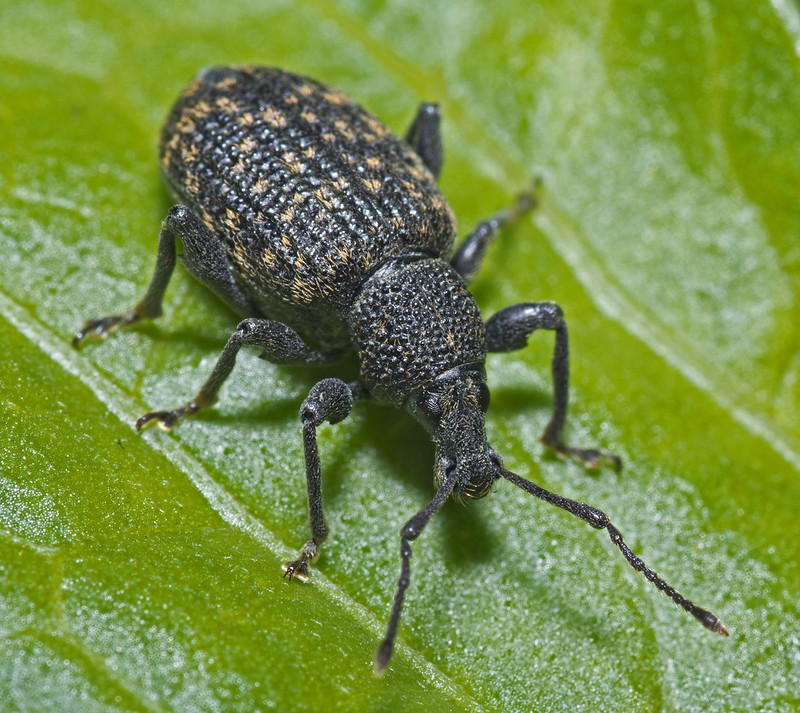
VINE WEEVIL (Otiorhynchus sulcatus)
Distribution: Widespread throughout Britain.
What to look for: Black body mottled with small brown patches. Their elytra, the hardened forewings that serve as protective cases for the hindwings, have longitudinal grooves, or striae. Their pronotum is pebbled in texture.
Similar species: There are several dark, grooved species, and the Large Pine Weevil (Hylobius abietis) is visually similar but has orange or creamy-yellow spots resembling bands and their elytra lack defined grooves.

GREEN IMMIGRANT LEAF WEEVIL (Polydrusus formosus)
Distribution: Widespread, increasing population.
What to look for: A metallic green species with round scales and pale antennae that end in a dark club. Their elytra are longitudinally striated and do not have any setae (stiff structures that resemble bristles). Older specimens may be darker in colour as their scales can wear off, showing their black under-colour. Their legs have some metallic green covering but with an orangey under-colour.
Similar species: There are several visually similar species, therefore specimens need to be examined closely. Identification in the field may be difficult.
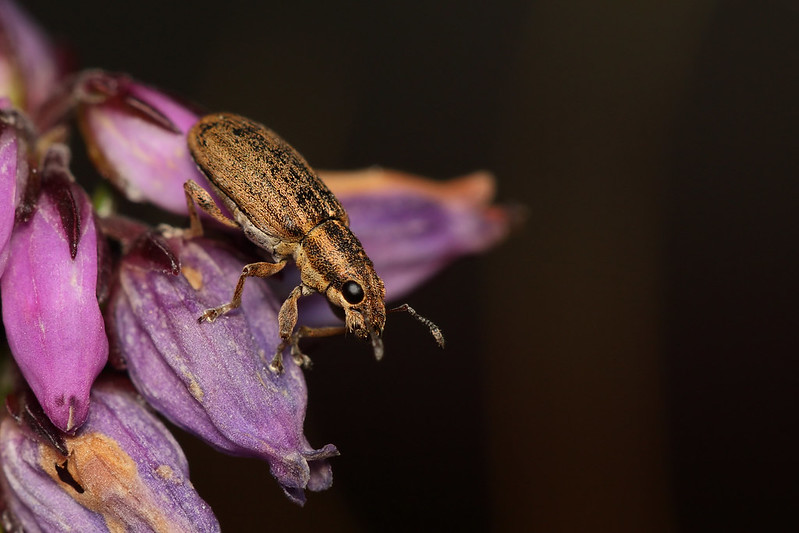
PEA LEAF WEEVIL (Sitona lineatus)
Distribution: Widespread in England and Wales.
What to look for: This is a buff species with dark longitudinal stripes that can appear dark brown or reddish. Its rostrum, or snout, is very short, unlike those of many weevil species.
Similar species: There are several similar Sitona species. Identification in the field may not be possible and dissection is often needed to confirm species.
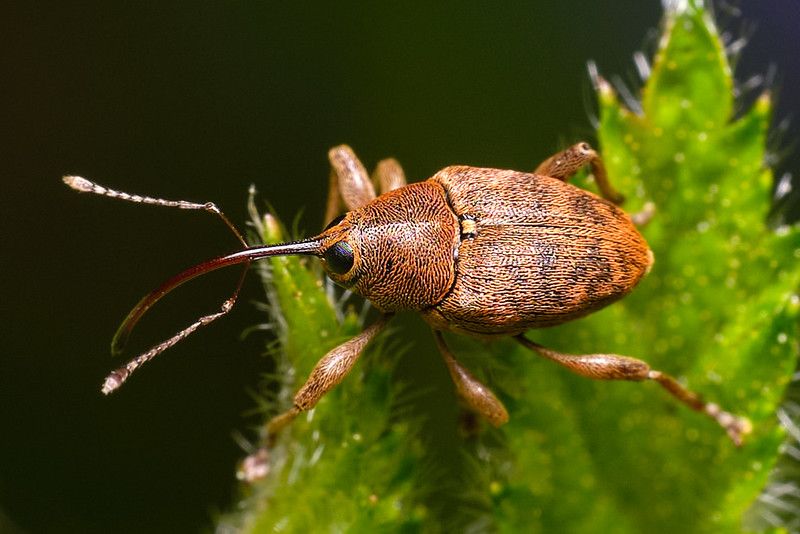
ACORN WEEVIL (Curculio glandium)
Distribution: Widespread, more common in the south of Britain.
What to look for: The Acorn Weevil is a brownish-rust colour with darker markings on its elytra. It has a long, striking rostrum and a paler scutellum.
Similar species: Very similar to Curculio nucum but can be distinguished by the shape of the antennal club which is more elongated and narrow than that of C. nucum.

NETTLE WEEVIL (Phyliobius pomaceus)
Distribution: Common in England and Wales, rare in Scotland.
What to look for: A black beetle covered in metallic, bluish-green scales, which are oval. There is a prominent tooth on the front femur.
Similar species: There are multiple similar species in the Phyllobius genus. The Nettle Weevil is the only one with oval scales.
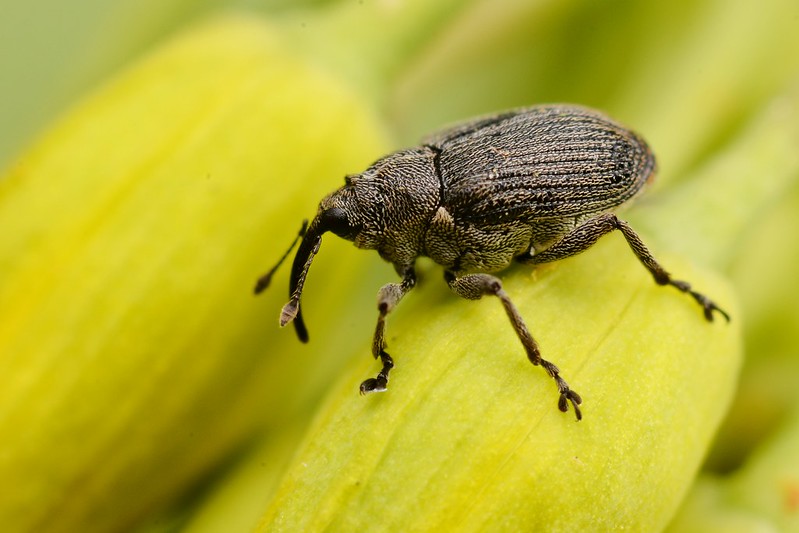
CABBAGE SEED WEEVIL (Ceutorhynchus obstrictus)
Distribution: Fairly widespread in England and Wales.
What to look for: The Cabbage Seed Weevil has a round grey body with grey legs. They are covered in small, white scales. They have a long, curved rostrum and small, bent antennae. If disturbed, this weevil will fold its rostrum and legs against its body, resembling a small pebble.
Similar species: Several other Ceutorhynchus species are very similar to C. obstrictus but they can be distinguished from some by the colour of their tarsi, the last part of the insect leg, which are black to dark-brown rather than reddish-yellow. C. Obstrictus also lacks a tooth on the hind femora.
Synonym: Ceutorhynchus assimilis, Cabbage Seedpod Weevil.

WILLOW GALL WEAVIL (Archarius salicivorus)
Distribution: Widespread in Britain.
What to look for: A short, black weevil with a tapered body and long snout. Its antennae are midway along the rostrum. It has a paler underside and a small pale scutellum, the small section of the exoskeleton in the middle of the back between the pronotum and the abdomen
Similar species: The Strawberry Blossom Weevil (Anthonomus rubi) is visually similar but has a less rounded appearance when viewed from above and a less barrel-shaped pronotum than the Willow Gall Weevil.
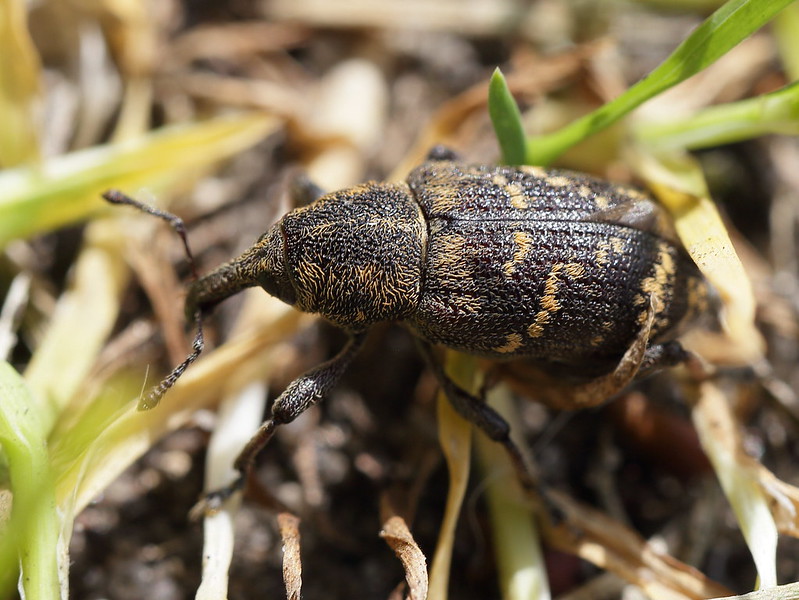
LARGE PINE WEAVIL (Hyblobius albietis)
Distribution: Widespread.
What to look for: This is a large dark brown weevil with orange to creamy-yellow patches on its elytra, which form bands. They have black or deep red legs with a distinct tooth on the femora and at the end of the tibiae. They also have eyebrow-like patches on their head at the base of their rostrum.
Similar species: The Vine Weevil (O. Sulcatus, see above) is also dark with lighter patches, but these are brown and their elytra have more distinct striations. They also have a more distinctly ‘pebbled’ pronotum.






